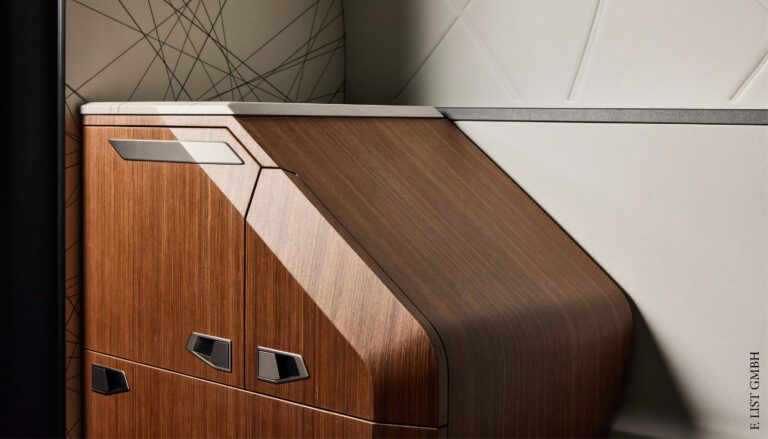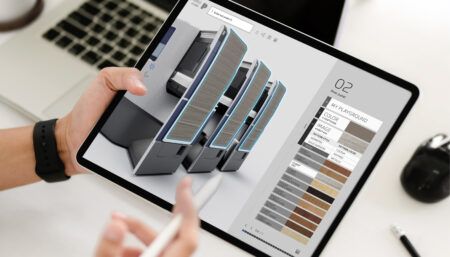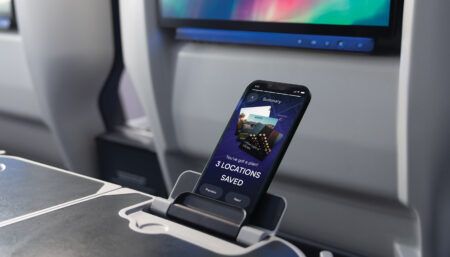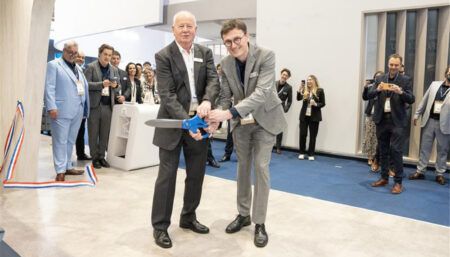From a fresh new idea for veneer to exciting IFE products and more – read on for some of the most eye-catching developments of 2024.
F/Lab Natural Oil
At NBAA-BACE 2024, Pilatus and F/List unveiled the fruit of their latest collaboration: a mockup of part of a Pilatus PC-24 cabin. It showcased American Walnut veneer cabinetry finished in a new offering: the transparent, plant-based, F/Lab Natural Oil. This was complemented by a bulkhead in F/Lab Aenigma Eco incorporating recycled stone dust; side panels in F/Lab Whisper Leather, the upper portion with lines of F/Lab Fresco Décor; and an F/Lab Linfinium countertop incorporating precious marble remnants.
Michael Müller, MD at F/List, explains that the collaboration was inspired by two trends: demand for sustainability, and natural surfaces being recognised as luxurious. Pilatus is the first aircraft OEM to employ the F/Lab Natural Oil. Müller believes it’s poised to be a game-changer for private aviation.
“Everyone entering a private jet currently is used to the cabinet being finished with lacquer,” he says. “There’s 1mm of lacquer surface, and underneath is a beautiful veneer. I hate it because you’re not able to touch it.”
He says the oil allows the warmth and grain of the veneer to be appreciated. F/List shares that the oil isn’t yet certified but is qualified for aviation, having gone through the qualification process with a customer. “It was difficult to bring it to market, regarding flammability requirements, because you have the veneer treated in the right way, then you just apply the oil,” says Müller.
This means it should save a lot of time in aftermarket refurbishments too, he says: “In refurbishment, the lacquering process takes up to four weeks, but you can do the full oil veneer finish process in one to two weeks. It’s downsizing the lead time by 50%.”
Müller shares that oil-finished surfaces have proven an eye-catcher with customers visiting the F/Lab showroom in Austria.
On the topic of durability, he explains that F/List introduces a new product first in its residential business, then if a success in terms of demand and robustness, it’s introduced to aviation. The oil has graduated this process.
“If you have a scratch in a semi- or high-gloss surface, you do a re-lacquer or polish respectively,” he says. “With the oil surface, where you have a scratch, you just apply a bit of oil and rub it there and it’s finished: it looks completely fresh and new. It’s going to be a completely new era for the aftermarket.”
For more on the mockup, including comment from Pilatus, see the hard materials feature in the December 2024/January 2025 edition of Business Jet Interiors International.
Venue CMS smart monitors
The first deliveries have been made of Collins Aerospace’s upgraded Venue CMS. Over the years Venue has been installed on more than 1,700 aircraft, of 50 different types. “Venue scales really well from small light jets all the way up to VVIP aircraft,” says Nathan Voight, VP and GM, business and regional avionics, Collins Aerospace.
A key upgrade is its integration with Collins’ new smart monitors, which are available in five sizes, and enable 4K resolution. The smart monitor also works independently as a standalone IFE solution for content and Collins’ HD Airshow.
“From a form factor standpoint, they’re pretty compact, but allow you to use a specific monitor as the entire system,” says Voight. “Each has 4TB of storage. They house the software for the entire system on each monitor.”
When replacing an LRU, such as a monitor, the Venue system recognises the new unit and automatically programs it to match the system already in place. “It’s really bringing a small form factor that makes it easier to install,” says Voight. “It’s more intuitive from a maintenance standpoint as well; it shortens the install time because you’re not running additional cables and wiring to a processing or media server unit, you’re doing it all right there within that monitor.”
As well as the form factor, which Voight says makes the monitor “less invasive” to install, the solution includes a diagnostics application to ease maintenance in the case of a fault. “You don’t have to try to deconstruct the system to troubleshoot, to find out where the issue is,” he says.
Other updates include a graphical user interface (GUI) redesigned to be more intuitive to use across touchscreens, seat controls and PEDs. “Most principals in the cabin are used to touch technologies on their iPad, their phone, and we wanted to make that experience really consistent when they get onto the aircraft,” says Voight. “They can have an application on their own iPad and use that to control the entire system.”
“If you have a fleet or charter operation with Venue installed, you don’t need a different application for each aircraft; the app identifies which aircraft you’re on, and automatically updates to the configuration of that aircraft,” continues Voight.
The new version of Venue also offers the capabilities it had already – including the Airshow 3D moving map; Stage media content solution; and cabin management functions. “We’re looking to continue to make enhancements, make it easier, and incorporate consumer technologies as they become available and make sense within the aircraft – different display sizes and shapes, things of that nature,” says Voight.
The solution is targeted at the aftermarket. “We don’t have a linefit position for the Venue smart monitor,” he continues. “A lot of the success we see with Venue is in the aftermarket, where someone wants the flexibility of customising a solution.”
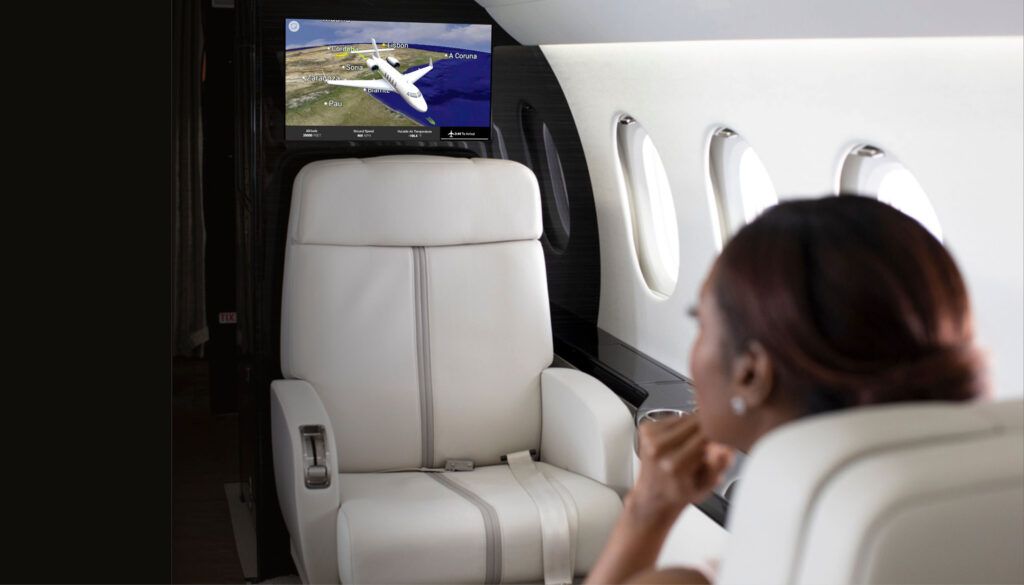
Customisable IFE/CMS
Jet Aviation has developed its first in-house IFE and CMS software solution for use in VIP aircraft, implemented with hardware from Crestron Electronics that has been certified for aircraft use by Jet Aviation.
Crestron Electronics is an established name in the residential and yachting sectors, and Jet Aviation cited hardware reliability, availability of spare parts, service support and simplified obsolescence management as key benefits of the partnership.
Jet Aviation’s engineering team in Basel, Switzerland, developed the software for the customisable and scalable solution. The interface enables control over lighting, cabin crew calls, audio, video, and custom functions.
The company said the in-house offering would simplify the process of adaptation for customers. It’s available for installation as part of Jet Aviation completion and refurbishment projects. As well as fixed hardware components for crew and customer areas, passengers’ tablets can be used for remote control throughout the cabin.
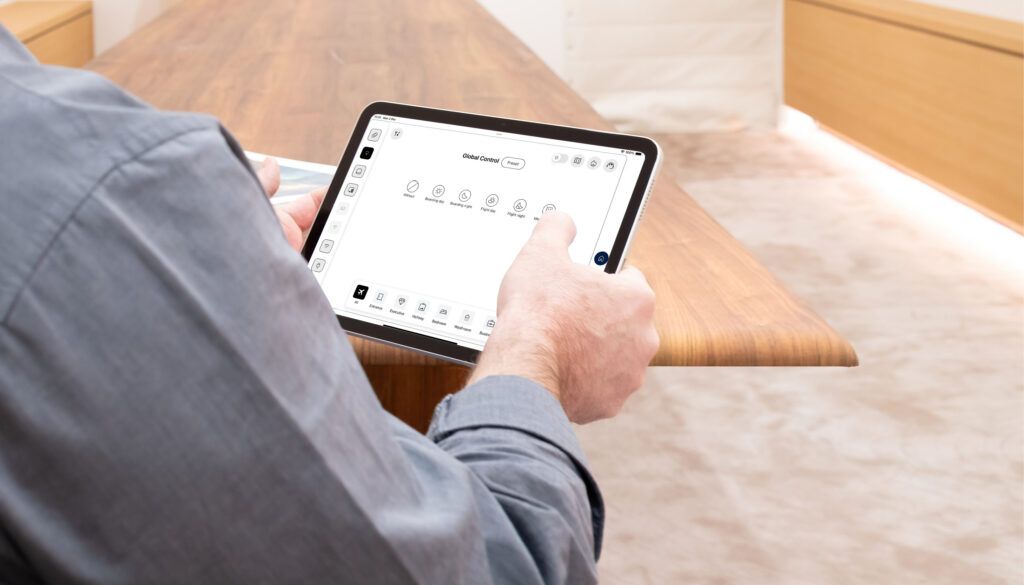
Real-time online video-gaming
The latest addition to Innovative Advantage’s Audio, Video, and Data Distribution System (AVDS), for all business aircraft platforms, is video-gaming capabilities. The company noted that the move was enabled by the growing availability of low-latency, high-bandwidth LEO and ATG connectivity systems.
The AVDS System, in combination with fast internet connection, can provide a lag-free experience from controller to monitor, Innovative Advantage explains, as it has distributed architecture with a fibre optic backbone.
“We distribute all our video raw, and any processing required is done with high-end FPGA solutions developed in-house by our Kirkland (Washington)-based engineering team,” says Greg Cornell, president at Innovative Advantage. “This means the absolute highest video quality, and none of the latency or lip-sync issues that you’d have with other architectures. Nothing but pure, beautiful 4Kp60 HDR video and uncompressed surround-sound audio.”
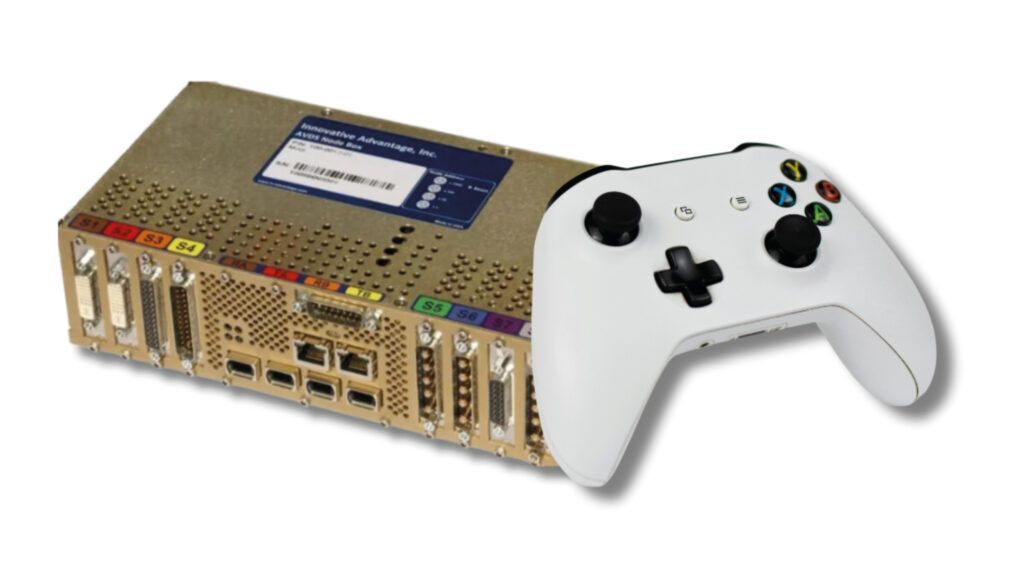
Immersive audio and display updates
Rosen Aviation launched an in-seat audio system, which it demonstrated at AIX and NBAA-BACE in 2024 as part of its PO-RT-AL (Personally Optimized – Real Time – Augmented Luxury) setup. This also includes digital windows and skylights, a curved carbon-composite OLED IFE display, hologram controller and a smart cupholder with automatic heating and cooling.
The Immersa AudioSphere, designed with audio engineer Laurence Dickie, mainly leverages newly patented soundwave propagation technologies, with additional digital signal processing (DSP). In the concept demonstrated, there are 24 headrest speakers, two mid-range speakers in the lumbar area, and a haptic driver in the base of the seat. “A complex algorithm causes each speaker to fire individually at a slightly different interval,” says Justin Watson, customer success manager at Rosen Aviation. “We get these converging soundwaves that collide where your ears are. The waves stack on top of each other and you hear it the loudest right at your ears. As they travel away from your ears, the waves end up cancelling each other out and dissipating. We’re getting about 20dB per metre of attenuation; the further away you are, the quieter it is.”
Watson says this creates an “audio hologram” with tone, timbre, depth and width, ensuring that “when you’re watching a movie, you get the sensation of where individual sounds are coming from”. Rosen’s plans to develop the concept further include enabling lie-flat capabilities.
The company also announced updates to its IFE displays, including smart capabilities, 4K HDR resolution, a weight-saving carbon-composite chassis and next-generation electronics that use Qualcomm’s 8550 mobile processor. “Mobile processors are designed to be very fast, powerful and efficient,” says Watson. “What we essentially have created is a light IFE system that can stand independently from the cabin system. It can act as the server, host, distribute and sync everything, so we don’t need additional boxes to support this if you want to just install new displays and have a new smart system.”
The displays can host a 4K 3D moving map, rendered in real time. Displays can sync together to play the same content simultaneously. The electronics can be mounted to the display or located hundreds of feet away with a fibre optic connection and centralised electronics bay – enabling the displays to be thinner.
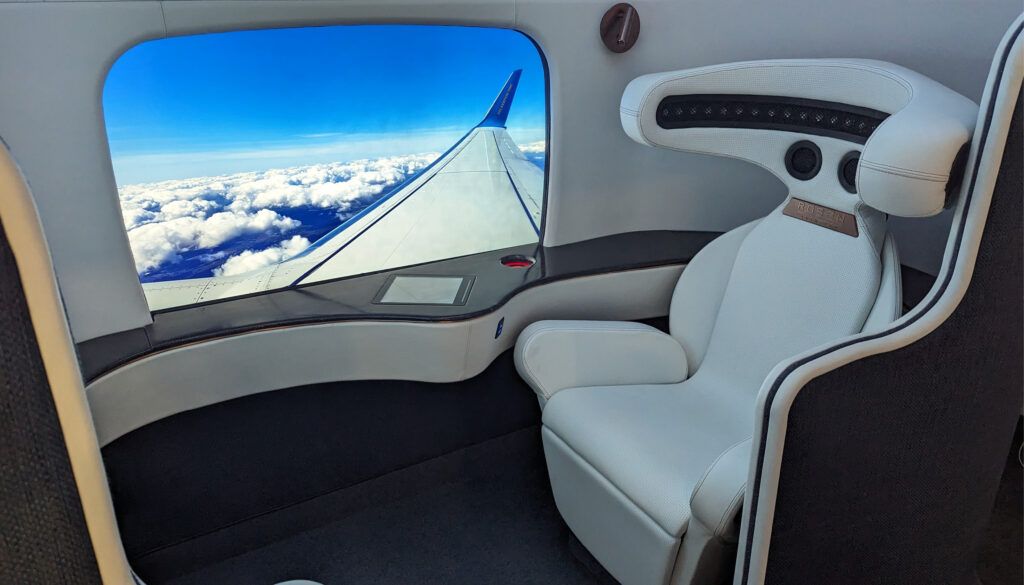
This feature was written by Izzy Kington and first published in the December 2024/January 2025 edition of Business Jet Interiors International. Click here for the full article.


